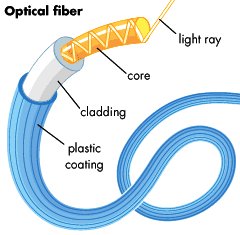Science & Technology
New Technique for Monitoring of Power Transmission Cables
- 15 Mar 2021
- 5 min read
Why in News
Recently, researchers at IIT Madras have demonstrated that power transmission cable can be monitored by using Raman thermometry on the fibre optic cable.
- They achieved this by using the optical fibres that are already embedded in the power cables for establishing optical communication.
Key Points
- Raman Thermometry:
- It is a thermal characterization technique which makes use of Raman scattering phenomena to determine the local temperature in microelectronics systems.
- When light is scattered off an object, say a molecule, two bands are observed, with higher and lower frequency than the original light, called the Stokes and anti-Stokes bands, respectively.
- By studying the relative intensity of the two bands, it is possible to estimate the temperature of the object which scatters the light.
- The anti-Stokes component of Raman scattering is strongly dependent on the temperature that the material is subjected to. Thus, by measuring the intensity of the anti-Stokes scattered light we can estimate the temperature.
- Any current flowing through a conductor would cause a temperature rise due to the Joule heating effect. Hence the flow of current through the power cables results in heating of the power cables.
- Joule heating (also referred to as resistive or ohmic heating) describes the process where the energy of an electric current is converted into heat as it flows through a resistance.
- Optical Fibre Technique:
- The temperature measurement of wires is performed in not just one location, but in a distributed manner using an optical fibre. To achieve this, a pulse of light is launched into the optical fibre and the backscattered radiation is observed.
- Optical fibres are fabricated with high quality composite glass/quartz fibres.
- Each fibre consists of a core (denser) and cladding (rarer).
- When a signal in the form of light is directed at one end of the fibre at a suitable angle, it undergoes repeated total internal reflections along the length of the fibre and finally comes out at the other end.
- Total internal reflection is complete reflection of a ray of light within a medium such as water or glass from the surrounding surfaces back into the medium.
- Since light undergoes total internal reflection at each stage, there is no appreciable loss in the intensity of the light signal.

- Optical fibres are fabricated with high quality composite glass/quartz fibres.
- The time of flight of the backscattered radiation provides an estimate of the distance from which the light is backscattered.
- Backscattering (or backscatter) is the reflection of waves, particles, or signals back to the direction they came from.
- This constitutes a distributed measurement as the pulse propagates all along the length of fibre.
- This can go up to tens of kilometers.
- The temperature measurement of wires is performed in not just one location, but in a distributed manner using an optical fibre. To achieve this, a pulse of light is launched into the optical fibre and the backscattered radiation is observed.
- Significance:
- Actual Temperature Measurements:
- The use of Raman thermometry technique allows the operators to get the results for actual temperature measurements over tens of kilometres.
- Economic and Real-Time:
- Alternative methods of measuring the temperature of power cables include using a thermal camera which is cumbersome. The present method devised by the team is both economical and provides real-time information.
- Thermal cameras detect temperature by recognizing and capturing different levels of infrared light.
- Alternative methods of measuring the temperature of power cables include using a thermal camera which is cumbersome. The present method devised by the team is both economical and provides real-time information.
- Actual Temperature Measurements:
Raman Effect
- The Raman Effect or Raman Scattering is a phenomenon in spectroscopy discovered by the eminent physicist Sir Chandrasekhara Venkata Raman in 1928.
- In 1930, he got a Nobel Prize for this remarkable discovery and this was the first Nobel Prize for India in the field of Science.
- The Raman Effect is a change in the wavelength of light that occurs when a light beam is deflected by molecules. When a beam of light traverses a dust-free, transparent sample of a chemical compound, a small fraction of the light emerges in directions other than that of the incident (incoming) beam.
- Most of this scattered light is of unchanged wavelength. A small part, however, has wavelengths different from that of the incident light; its presence is a result of the Raman Effect.




